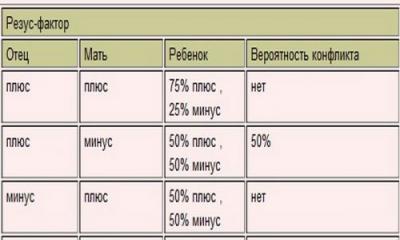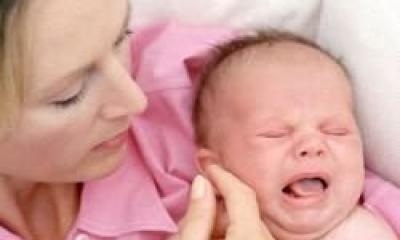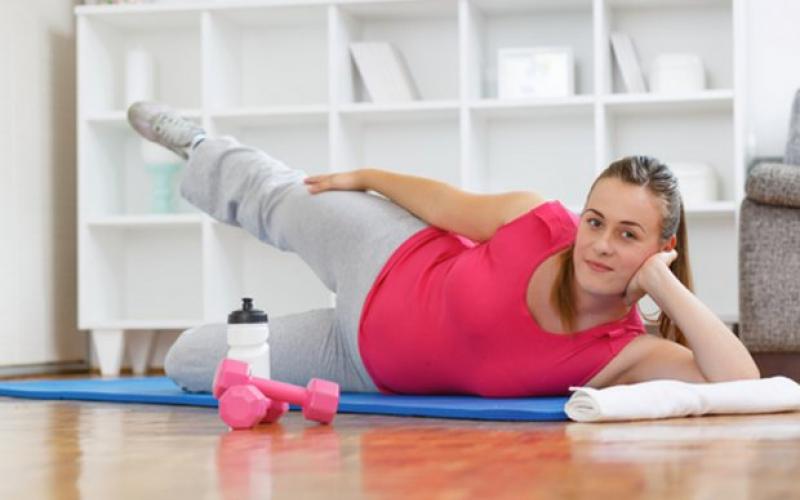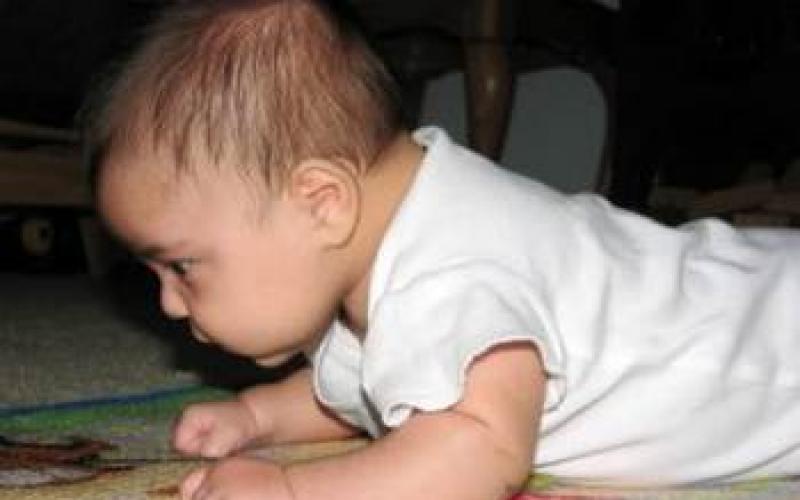- What does a child of 4-5 months know and can do?
- What a child knows and can do at 5-6 months
- Useful games for children up to six months
- Gross motor skills: learning to crawl
- Fine motor skills: push the buttons
- Developing attention: hiding the toy
- Developing speech: finger games
- Gross motor skills: kick and push
- Fine motor skills: holding the ball
- Introducing the kid ... to himself!
Soon your baby has his first "anniversary" - six months from his birthday! Until recently, he was just a tiny little bag that slept and ate, and now he is already actively learning about the world around him and loves to communicate with his parents. How to make these months joyful, intense and maximally useful for its development?
What does a child of 4-5 months know and can do?
Read about basic skills of a 4-5 month old baby
Physical development
The kid is already confidently holding his head, which allows him to start exploring the world around him. He has not only a strong, but also an accurate grip - he confidently takes the toys he likes, and if he drags them into his mouth, he does not miss.
Attention and memory
After three months, the child already firmly distinguishes between familiar and unfamiliar faces, moreover, he unequivocally expresses joy when mom and dad appear and dissatisfaction at the sight of, for example, a medical form, if he did not like the previous meeting with the doctor. He can concentrate on an object in the hands of an adult for a long time and recognizes his favorite toys.
Speech
Sounds at this age play an important role in a baby's life - he begins to perceive their emotional color. A child can cheer up when he hears a joyous melody and be upset when he hears angry voices.
He himself is already beginning to master speech - from agukanie he goes on to babbling, in which several distinct syllables can already be distinguished.
What a child knows and can do at 5-6 months
Read about basic skills for a 5-6 month old baby
Physical development
Now the baby needs an eye and an eye - after all, he has already mastered the technique of turning from tummy to back and again to tummy. With such a "kolobok" he can roll off the sofa or bed, if the sides do not stop him! Some babies at this age are already mastering such a useful skill as crawling, but this is not necessary - there are lazy people who do not want to crawl at all, and later immediately start walking.
The child is no longer just confidently holding toys, but can already shift them from hand to hand, feel.
Attention and memory
The child begins to find "hidden" objects. If, for example, you took a toy and hid it in front of him under the pillow, he can already logically comprehend the “mysterious disappearance of the bear cub” and get the toy out of the hiding place.
Speech
The kid already steadily associates many words with phenomena and objects. He not only turns his head to you when you call him by name, but can also answer simple questions with gestures: "Where is mom, where is dad, where is woman?"
Useful games for children up to six months
Gross motor skills: learning to crawl
Turn the baby over on its tummy and offer him an attractive toy at such a distance that he cannot grab it. Let it stretch and try to crawl towards the goal! When you notice that the child’s mood is spoiling, let him take the toy.
Fine motor skills: push the buttons
By the age of four months, the baby is already good enough with his palms to start exercising with complex toys that make sounds when pressed. Ordinary rubber "squeaks" will do if they are comfortable for a child's handle, but you can find more complex toys with musical buttons and keys.
Developing attention: hiding the toy
As we have already mentioned, a child at this age already understands that the object is hidden and knows how to find it. So you can well play with him in such a kind of hide and seek. Probably, the first few times you yourself will have to "save the lost bear." If you demonstrate your joy at the same time, the baby will quickly understand the meaning of the game and actively engage in it.
Developing speech: finger games
Gross motor skills: kick and push
Toys can not only be gripped with a brush, but also kicked and thrown - a very useful skill that should be developed. A light ball is ideal for this - roll it on the floor towards the child to get kicked off. You can hang the toy over the baby's crib in such a way that he can kick it, jerking his leg.
Fine motor skills: holding the ball
A child at this age confidently grabs the rattle, squeezing their handles in a fist. But he still has no experience of interacting with objects of complex shape. Try to find small balls or soft cubes that are large enough for your child to hold with their palm open. Practice shifting such items from one hand to the other.
Introducing the kid ... to himself!
In fact, the child already knows very well what his mother and other family members look like, but does not yet know what he himself looks like! A large mirror will come in handy here. Approach him with a child in your arms, show first yourself and your reflection, then at the child and his reflection.
Six months is an amazing and wonderful age, but remember - this is just the beginning! It will be even more interesting further!
In this article:
The development of a child from 4 to 5 months is characterized by noticeable physical and psycho-emotional changes. During this period, the kids are already consciously trying to grab objects that interest them, throw them, watching the effect, rejoice at the appearance of loved ones. Most children by this time calmly roll over from back to stomach.
Features of physical development
Between 4 and 5 months of life, the baby continues to actively grow and gain weight. Compared to the previous month, the child's weight will increase by an average of 750-800 grams, and his height - by 2-2.5 cm. The lungs during this period are twice as heavy as newborns, the pancreas and liver increase in size.
At this age, the baby is much easier to cope with the digestion of food, he is less likely to suffer from intestinal colic and he is already quite capable of sleeping all night without disturbing his parents with a hungry cry.
Previously, it was generally accepted that the appearance of the first teeth in a child could be expected no earlier than six months of age. Today, children develop a little faster, so many of them have their first tooth by the end of the fourth month.
The fact that the child will soon have teeth can be judged by the profuse salivation, frequent crying, especially at night. You can determine that the incisors will really appear soon by gently sliding your finger along the baby's gums.
Often enough  the imminent appearance of incisors indicates heat and upset stomach in a child. To exclude a number of diseases with the same symptoms, it is necessary to consult a pediatrician when they appear.
the imminent appearance of incisors indicates heat and upset stomach in a child. To exclude a number of diseases with the same symptoms, it is necessary to consult a pediatrician when they appear.
Between 4 and 5 months of age, children practically do not bother their parents crying for no apparent reason. They have almost adapted to the new living conditions and are often in excellent spirits.
Features of the mental development of the baby
One of the main indicators social development crumbs in the period from 4 to 5 months are sincere joy and pleasure at the sight of relatives and friends, usually accompanied by a smile and active movements of the whole body. At this age, the baby is still gullible and does not show hostility to strangers. He rejoices in the appearance of any person who will try to establish contact with him. With all his appearance, the baby tries to demonstrate readiness for communication.
By the end of the fourth month, the walking reflex finally disappears. It is easy to check if you put the baby on a hard surface,  holding it under the arms - his legs will remain in a bent position, the imitation of steps will disappear.
holding it under the arms - his legs will remain in a bent position, the imitation of steps will disappear.
Most babies at this age respond positively to music and pleasant sounds, looking for their sources, actively turning their heads from side to side. They can already be carried away by bright toys with a built-in music unit.
Children at this age recognize their parents and closest relatives not only by smell, but also visually. When communicating with a baby, it is important to stand over him in such a way that the light illuminates your face well. Mom can use bright lipstick to draw the baby's attention to her face. The baby will follow the movements of the painted lips with great interest and even try to repeat them.
Features of the development of the baby's feelings
One of the main changes in a child's life is that he finally begins to see not only those objects that are located at a distance of 40 cm from him.Now, between 4 and 5 months, the baby is able to focus his gaze on any object, no matter at what distance he is from him. New abilities open up new opportunities for the kid - to see the whole world!
In this period  it's time to start developing the baby, introducing him to the world around him:
it's time to start developing the baby, introducing him to the world around him:
- in home;
- out of the window;
- on a walk.
During walks, you can show the baby new objects, people, animals, drawing his attention to their shape, height, sounds made and even remoteness.
During the same period, the child continues tactile acquaintance with the world. He probes everything that comes to his hand. You can offer the baby to compare the sensations of touching different surfaces, let him touch cold and warm objects.
Also in this  at age, the child's vision is formed, therefore, parents need to select toys for him with special care. The baby will react most actively to toys of bright colors, as well as colors that are as close to natural as possible. From 4 to 5 months, the child is not recommended to look at the screens of TVs and tablets, which will be much more useful to replace with observations at the window and full-fledged walks on the street.
at age, the child's vision is formed, therefore, parents need to select toys for him with special care. The baby will react most actively to toys of bright colors, as well as colors that are as close to natural as possible. From 4 to 5 months, the child is not recommended to look at the screens of TVs and tablets, which will be much more useful to replace with observations at the window and full-fledged walks on the street.
How does motor function develop?
Between 4 and 5 months, the baby already consciously controls his own hands, developing their movements. Parents can help the baby to improve hand coordination, for example, by offering to hold  rattle with both hands at the same time, and then transfer it from one hand to the other.
rattle with both hands at the same time, and then transfer it from one hand to the other.
To improve the baby's coordination, it is good to use such a game. Lay the child on his back, grab him in the area of \u200b\u200bthe forearms, then slowly help him to sit down, saying that he is "growing big, big", then gently put the baby on his legs and slowly lay him on his back again.
How does the baby's speech develop?
It's hard to believe, but between 4 and 5 months, the baby actively develops speech, which is replenished with numerous vowels. The child enjoys practicing speech skills, communicating with loved ones, trying to copy their intonation. For correct development speech from this age is necessary as much as possible  more often:
more often:
- talk with the baby about everything in the world;
- tell him stories;
- read rhymes;
- describe the surrounding objects, phenomena, etc.
During such communication, you need to respond positively to the baby's babbling, letting him know that you hear him, understand and enjoy the dialogue. Try to speak slowly, understandably, with pauses and observance of intonations, stop when the baby enters into a "conversation", carefully listening to his babble.
Remember that at this age the emotional world of the child is being transformed, so it is very important for him to have a model of how to gesture, change intonation and facial expressions during communication. The older the baby becomes, the better he will understand the speech addressed to him.
Every mother is obliged to know about the changes that occur with the child at every stage of his development. After all, a mother should be aware of the peculiarities of growth, so that in case of any discrepancies, immediately consult a doctor. This article details the development of a 4-5 month old baby. At this stage, a lot of changes are taking place with the baby, which are worth talking about.

At about the fourth month of life, changes in the proportions of the head and body occur. The next two months are a period of rapid growth internal organs... This is what explains the changes in physique. At the same time, there is a rapid development of the organs of sight and hearing. Therefore, children of this age are greedy for bright and sonorous rattles. At this age, it is already possible to involve the baby in various games aimed at developing tactile sensations, physical development, as well as hearing development.
A baby at four months can already hold his head lying on the surface. He tries to lift the little body and keep it in weight for several seconds. And at five months, the child can already hold the body in an elevated position for about a minute. Children at this age are surprisingly agile. For example, a baby can roll over from the abdomen onto the back and return to its original position without the participation of the parents. Most of all, they like to lie on their tummy, since in this position it is convenient for them to observe the world around them.
At this stage of development, the child gives out the first smile, learns to recognize the touch of the hands of a loved one, makes the first sounds with a color of a certain intonation, looks for ways to attract attention. In addition, if someone unfamiliar takes the child in his arms, he may well burst into tears due to the fact that he does not know this person. After all, the child has already managed to remember the smell, voices and faces of the parents. Now, when the baby cries, he adds certain sounds like "agu-agu" to his cry - this is how he calls his mother, communicates in his own way.

Often, at this stage of development, some children begin to grow hair rapidly, which subsequently becomes thick head of hair. Up to a year, until the fontanel is overgrown, it is not recommended to cut the baby. But with marigolds, the situation is different - they must be cut regularly so that the baby does not scratch himself.
For a month, on average, a child gains weight about 600-750 grams, while growth increases by 2-3 centimeters. The head girth is already less than the chest girth, so the baby's physique becomes more proportional.
At the fourth month of life, the baby still has enough breast milk. In addition to milk, he should also be given boiled water to drink. If there is not enough milk, you can start giving him formula for feeding. In the fourth month, you can already feed the baby with complementary foods, mashed potatoes. However, before this, it is imperative to consult a pediatrician.

Therefore, be very attentive and observant. Make sure that the toys are free of small parts that the child could pull into the mouth. At this age, the baby keeps his ears on top of his head, listening to each new sound coming from the TV, game or outside the door.

A four-month-old baby becomes more attentive, active and cheerful. It changes physically and emotionally, delighting parents with new skills and achievements. What did a baby learn by 4 months and how can you help the development of a toddler of this age?

Physiological changes
- A 4-month-old baby significantly strengthens his back muscles and improves their coordination, as a result of which the baby learns to roll over. Nevertheless, the baby cannot sit yet, therefore, it is not recommended to seat him with support in the form of pillows.
- Many reflexes characteristic of a newborn have already disappeared or are starting to fade, such as crawling and Moro reflexes. The hypertonicity of the arms has already completely disappeared, but in the legs it is still preserved.
- The baby's lacrimal glands begin to work, so when the baby cries, tears already appear.
- The baby's vision begins to perceive more and more colors. The little one likes the pure tones of yellow, red, blue and green. If the baby has strabismus after childbirth due to weakness of the eye muscles, it should go away by 4 months, as the eye muscles become stronger.
- The child's hearing is also actively developing. Hearing sounds, the baby turns in their direction. The kid already knows how to distinguish the voices of loved ones from the voices of strangers. Hearing the music, the little one begins to shake his head in time. The little one likes rhythmic melodies with low tones more than high tones.
- The work of the baby's digestive system has already improved and has become more stable, the colic in most children has already passed.
- In some babies, the formation of saliva increases, but this is not due to the appearance of the first teeth, but to the constant finding of hands and various objects in the baby's mouth, which he studies in this way.
- The hair and nails of a 4 month old baby grow very quickly.
Emotionally, a baby of this age becomes more developed and is in great need of communication with adults. Among all people, the baby especially distinguishes the mother and reacts to her mood. If mom is sad, the baby will feel it, and he will certainly respond to his mother's smile with his own charming smile.

Physical development
Since the physical activity of a 4-month-old baby is still low, the weight gain at this age is quite large and amounts to about 750 grams. The growth of the baby becomes 2.5 cm larger, and the circumferences of the head and chest at this age become the same (by the fifth month, the chest becomes larger than the circumference of the head).
Although all babies develop differently, the averages for most babies of this age and the limits of the norm help to reveal whether the infant is growing normally and whether the pediatrician should be drawn to the excess or decrease of any of the parameters of physical development. We presented the norms for 4-month-old babies in the table:
What can the kid do?
- Lying on its stomach, the baby confidently holds its head and examines everything around. Moreover, the baby can already raise the entire upper body with his head and lean on his palms.
- By the age of four months, the baby has mastered tummy flips from a supine position. Some babies have even learned to roll over and try to crawl on their stomachs, helping themselves with their legs.
- Lying on its back, the baby learned to raise its head along with the shoulder girdle. These are the first attempts of an infant to sit down.
- The baby is already good at managing her own hands. During feedings, the baby's arms often hug the mother's chest or wrap around the bottle. While in the crib, the baby already confidently grasps the objects that hang over it (mobile toys) with his hands.
- During play, the child smiles and laughs often. A child at the age of 4 months is very emotional, he can be both happy and upset or offended.
- The humming of a four-month-old baby is quite long. You will hear the sounds "a", "o", "b", "p" and "m" from the baby. Some kids even learned how to connect them into syllables.

Note that each baby develops at its own pace and some skills may appear earlier in the toddler, and others a little later than in peers. Nevertheless, there are skills, the absence of which at 4 months of age should alert parents. Contact your pediatrician if your baby:
- Missing items and not holding them in the handle for a while.
- Does not rise with support on hands when lying on stomach.
- Didn't learn to roll over on his stomach.
- In an upright position (when the parent supports under the armpits) does not rest his feet on the surface.
- When both handles are pulled, the baby's head tilts back.
- Does not show any emotions and does not respond to communication with people.
About whether to worry if there are deviations from the norms, see the video of Dr. Komarovsky.
About what, according to the norms, a child should be able to at 4 months, see the next video by Larisa Sviridova.
Development activities
- Hang over your child bright toys so that the baby can grab them with handles. It's great if such toys have different textures or make sounds.
- Place rattles of different sizes and different shapes... Offer the baby to touch not only the rattles, but also soft toy, a small doll, a musical toy with buttons, a rubber squeaker and other items.
- Play hide and seek with your baby. Hide your face behind a handkerchief, then open your face and say cuckoo. You can also close your eyes with your own hands, and then close your baby's eyes with your own hands. The crumb will certainly like all the options for the game.
- Play magpie-crow with the baby. Since there are centers on the palm that stimulate the intestines, such a game will be useful not only for the muscles of the arm, but also for digestion.
- Start up bubble and let the baby watch their slow flight.
- Put a bright-colored sock on one of the baby's legs so that the little one wants to grab it. You can also tie a bell to the baby's leg. Be sure to praise the baby when the child takes out the sock or bell.
- For better physical development and coordination training, take the baby by the arms, lift them up, and then lower them down along the body. After that, cross your arms over your chest and spread them to the sides.
- During gymnastics, massage and any other activities, together with your child, sing songs and recite nursery rhymes, and when putting the baby to bed, hum a lullaby or tell a fairy tale.
- Build "dialogues" with your baby so that the baby learns to imitate your speech. Speak different words so that the baby can see your facial expressions. It is also important to repeat after the baby the sounds that the child makes.

Try to teach your child the lesson "Worm", which is shown by Tatyana Lazareva in the next video.
Care
The morning of a four-month-old child, as before, begins with hygiene procedures. Wash the baby's face and wipe the eyes, clean the ears and nose if necessary. Toenails at this age have to be trimmed quite often, since they grow quickly, and the baby constantly puts his hands in his mouth.
You should walk with a 4-month-old toddler twice a day, focusing on the weather conditions. In summer, the duration of walks can be up to 6 hours. In winter, it is advised to go for a walk for 1-2 hours. Refrain from it only when severe frost, heavy rain or gusty wind.
Gymnastics and light massage are recommended for the child twice a day. First, lay the baby on the back, take the handles and make them in a circular motion. Then turn the baby on one side and on the other, then take the toddler's legs and move them. Next, the baby needs to be turned on its stomach, and in this position, bend and straighten its legs.

During the massage, you should use nursery rhymes.





The massage technique at 4 months is shown in detail by Nikolai Nikonov, a leading doctor and massage therapist in Russia, in the next video.
To improve falling asleep, a specific ritual should be created that will set the baby up for a night's sleep. This ritual may include bathing, stroking the baby's body, feeding, lullaby, or a fairy tale. Repeat this ritual daily, without skipping its elements.
Remember the safety rules and do not leave the crumbs alone, because many babies at 4 months have already learned to roll over, and those who have not yet succeeded can please with a new skill at any time.
For what a baby needs at 4 months first of all, see Larisa Sviridova's video.
Daily regime
The child can already be awake for more than 2 hours in a row and during these periods is very active.
A four-month-old child sleeps up to 15 hours a day. Night sleep at this age lasts about 10 hours. Daytime dreams in many children 4 months become three, and their total duration is about 5 hours. The optimal bedtime for a night's sleep is called 19-21 hours. If you start lying down later, it may be difficult due to overwork of the infant.
Kid on breastfeeding continues to receive exclusively breast milk... At the same time, the baby began to attach to the chest less often. This usually happens while falling asleep, during sleep, and immediately after waking up. As a result, the baby already has a fairly accurate feeding schedule.

The child has artificial feeding the diet is more strict. It provides for a certain amount of mixture and 6 feedings per day at intervals of approximately 3.5 hours. The amount of the mixture that the artificial baby needs per day is determined by dividing the baby's weight by 7. This total amount is distributed equally over 6 feedings.
On average, babies 4 months old eat 900-1000 ml of the adapted formula per day. For one feeding, the baby receives an average of 150-170 ml of the mixture. Also at this age, children receiving the mixture begin to introduce complementary foods.The first course of complementary foods is vegetables or porridge. The new product is given in the second feeding, increasing its amount to 100 g.
Do not forget to diversify the day of the crumbs with various nursery rhymes. One of them is presented by Tatyana Lazareva in the next video.
Calculate Your Complementary Feeding Chart
Child development from 4 to 5 months
Physical development
During this month, the baby, as a rule, adds about 650-700 grams in mass, and grows in length by about 3 centimeters. The head circumference increases by 1 centimeter and the chest circumference by 1.5-2 centimeters. At the fifth month, the baby lies on his stomach for a long time, he confidently rests on his forearms and keeps his head straight. Lying down, the child can look at the toys lying in front of him with interest, and even try to reach out to the toy. The kid strives to crawl on his stomach forward or backward, he can roll over from his stomach to his back. Not yet very confident and not for long, the child sits leaning against the support - in a child's chair or in pillows. The sitting position opens up new possibilities for exploring and playing with objects. The child shakes the rattle for a long time, listening to its sound, examines and pulls the toy into his mouth. Having dropped the rattle, the baby tries to find it with his eyes.
Do you think it's too early for the baby to crawl? Let's try to teach him this. So the baby is lying on its stomach. Place one or two familiar toys on the mat so that your baby's fingertips just touch one of them. Sit on the floor opposite and encourage him to reach for the toy. Perhaps his "floundering" with legs and arms will move the baby a little to the toy and he will touch it or grab it. Make it easy for your little one! Place him on his tummy so that the legs can rest against the wall when he starts to "flounder" to reach the toy. Maybe not on the first try, but success is assured! Or, place your hand to the baby's feet so that he can rest against it when he reaches for the toy. You can "push" a little, push on his feet, and he will move forward a little. Rejoice with your baby in success and be sure to praise him!
Mental development
Being in a room with adults, the baby tries to be an active participant in the events that take place around him. He tries to attract the attention of adults, "beckoning" them to him with various sounds. The child develops babbling, which intensifies if the adult speaks to him or smiles at him. At the sight of the parents, the baby can make so-called "shouts" of joy. Being alone, the baby can also pronounce various sounds and sound chains, and when an adult appears in the field of view, he begins to babble more actively.
With sounds, he can express pleasure or well-being. The baby listens carefully to the sounds that he utters, and rejoices when he hears them.
The baby's eyesight and hearing improve. He begins to notice color differences (yellow and blue), carefully looks at his parents, feels his mother's face with his hands, touches his nose, eyes, pulls his hair, and puts his fingers in his parents' mouths when they talk to him. The child notices changes in the environment (for example, when parents change toys on their mobile, perform actions with toys) and emotionally reacts to these changes. The kid begins to listen to the sounds of the environment - the phone rings or the rumbling of working household appliances, tries to find the source of the sound with his eyes. The distance at which the child reacts to distant sounds increases to 2.5-3 meters.
The child laughs loudly when they do something to him, for example, when dad picks him up and down, tickles, blows on his tummy and hair. Such games become a favorite pastime of the growing baby and parents. Putting the baby's hands on your lips or cheeks, you can make him laugh by pronouncing sound chains with different intonations and facial expressions, for example, "ba-ba-ba", "ma-ma-ma", etc.
What games and exercises with a baby are useful at this age? Take the child in your arms, bring it to the mirror, and draw his attention to the reflection (tap your finger on the mirror, ring the bell behind the mirror). First wave your hand in front of the mirror and say, "Hello, hello!", And then grab the baby's hand and wave it too. When you are in front of the mirror, perform different actions: clap your hands, shake your head, wave your hand, puff out your cheeks, show your tongue to the baby, etc.
The child is now learning to reach for objects and grab them with his hand. It improves grasping movements and hand coordination. Hang toys of different sizes in front of your baby on a string at such a distance that he can reach them. Do not hang them too far, otherwise, if the baby cannot reach and reach them, he will lose interest in them. Place a toy (a rattle, small cube, or stuffed animal) in your child's hand. The kid will learn to shift the toy from one hand to the other, knock the toy or throw it in front of him. Place several toys in front of him so that the little one learns to reach and pick up toys on his own. Do not forget to praise the baby for success!
Play music, but not very loudly. After a few seconds, turn off the sound, and then turn it back on. You will see that the baby notices when there is sound and when there is none. Do not leave the recorder turned on for a long time. A constant background sound is not very useful for the baby, he quickly begins to get tired, he may start to yawn or be capricious. Let the child listen to different music: slow, calm and rhythmic. Remember to talk to him about what kind of music he listens to (sad or funny). You can take the baby in your arms and dance with him, moving to the rhythm of the music. Smile and encourage your toddler to laugh. Children love to move to the rhythm of the music with their mother!
The kid continues to explore the surrounding objects. He not only listens to sounds and looks around. He especially likes to pull all objects into his mouth. So far, his mouth is the best tool for researching objects. He bites objects, licks, trying to feel them in different ways. Do not prevent the child from pulling toys into the mouth, while carefully monitoring their cleanliness. When he grows up and learns to study toys in a different way, the baby will not pull all objects into his mouth. In the meantime, give him toys of different shape, size and weight, from different materials (wooden, rubber, plastic, rags). The main thing is that the materials from which all toys are made are safe. And the objects themselves were not sharp and too small. Pulling toys into your mouth isn't just good for learning them better. It is also useful for later learning the skill of self-eating. In the future, the child can be given a drying or cracker in his hand and helped to bring his hand to his mouth. The kid will learn to bite and chew food. Introduce your baby to different taste sensations, but do it carefully so as not to cause allergies. You can smear the baby's fingers with honey and bring them to his mouth, if he himself does not pull them into his mouth. At other times, you can spread them with jam or sour lemon.
In addition, it is useful for a little person to learn new smells. This will further protect his life. Let him smell different smells, pleasant and unpleasant: the smell of your perfume, the smell of milk, the smell, melons, the smell of garlic, vanilla, etc. Roll up some cotton balls. Moisten one with perfume, the other with the juice of some fresh berry and take it to the baby's nose in turn. Remember that such experiments are unacceptable in children with allergies. Look at his reaction, and you will understand which smell he likes best. From unpleasant odors he will turn away and wrinkle his nose. After a few days, introduce your baby to other scents (yogurt, baby shampoo or soap, etc.). Do not bring very strong scent balls too close to his nose.








